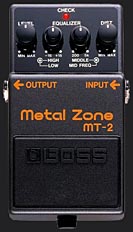CHIP
DESCRIPTIONS
JRC4558D – Made
by Japan Radio Corporation (JRC). Used in the original
TS808s and TS9s. Ibanez later changed the chip used in their pedals.
The JRC4558D is actually a very inexpensive chip that’s
not considered Hi-Fi and was chosen because of its inexpensive
cost and not for the tone it produced. It just happened
to sound great when used with the Tube Screamers original
circuitry.
This chip has a little bit smoother gain than the RC4558P which is
considered a more Hi-Fi chip. I like the JRC4558D in the
SD-1, it's smoother gain in the top end helps to offset
the extra hair in the SD-1's gain. I prefer the
RC4558P in a Tube
Screamer
because
the Tube Screamer circuit produces a smoother gain and
the RC4558P has a little more high end grit than a JRC4558D.
JRC4558DD – Made
by Japan Radio Corporation (JRC). This is a Higher Gain & Smoother
version of the JRC4558D (notice one has one "D" and the
other two "DD"s).
It's less Hi-Fi and has a smoother gain structure with a slight
rounding off in the highs.
This
"DD" chip
sounds
surprisingly
good in an
SD-1. This is the stock chip you'll find in most SD-1s and TS7s.
This is a good match for my SD-808. Try it and I think you'll
agree. My SD-808 has clearer top end and more hair. The JRC4558DD
tames the SD-808 a bit in the highs. Depending on your amp you
might like this chip better. I have a few of these. Contact me
if you want one, I don't have these listed for sell on my pedal
mods page because most people write them off as being a bad chip.
But, who cares what others say, the proof is in the tone and I
say they sound great with some SD-1 setups. Of course, YMMV.
RC4558P – Made
by Texas Instruments. Also used in the original TS808s and TS9s.
Ibanez later changed the
chip used
in their pedals. The RC4558P is also
a very inexpensive chip but considered to be a bit more Hi-Fi than the JRC4558D.
It just happened to sound great when used in a Tube Screamer
circuit.
These
are
still
very
popular
today
and
are
a great sounding
chip. Very similar tone-wise to the JRC4558D, has a little more high end
grit.
RC4559P – Made
by Texas Instruments. This is a more Hi-Fi lower noise chip than
it's brother the RC4558P. The EQ and gain structure is a bit different
than the RC4558P. I like this chip because of it's lower noise
when used in a GE-7. I also like this chip in a SD-1 and Tube Screamer
circuits. This chip changes the EQ of the gain and helps tame the
mids in a Tube Screamer.
LP353 -
Made by Texas Instruments. Very similar tone-wise to the JRC4558D
and RC4558P. Maybe a little less gain but
an excellent sounding chip. Subtle
differences.
This chip sounds excellent in a Tube Screamer, Daddy-O or SD-1. This is
a very popular chip with pedal modders.
NE5532 -
Made by Texas Instruments. Very similar tone-wise to the JRC4558D
and RC4558P. This is a more Hi-Fi, lower noise chip than both the
JRC4558D and the RC4558P. I really like the tone and gain of this
chip. In some ways I like it
better than a JRC4558D or RC4558P. Rich, smooth gain with nice overtones.
This is a very popular chip with pedal modders.
TL072 -
Made by Texas Instruments. Very similar tone-wise to the JRC4558D
and RC4558P. This chip has a very interesting
tone. A little more complex
than any of the other chips I sell. Very defined harmonics, especially
at higher volume. This chip is very Hi-Fi with low noise and a
great sounding gain structure.
OPA2134PA – Made
by Burr Brown. This is the most expensive opamp chip I sell. This
is a very popular chip with audiophiles. It’s low noise and
excellent sound properties make it a popular choice with pedal modders.
I especially like this chip in a Boss SD-1. It has a little more
edge than a JRC4558D or RC4558P
and is a tad cleaner with a flatter EQ which makes it a great chip
to tame the mids of a Tube Screamer or SD-1. Very rich and defined
gain with excellent harmonics and note detail.
You
can’t
go wrong with this chip. Highly recommended.
LM308N Ð Made by National Semiconductor. If you want that Vintage RAT tone that made the RAT one of the most popular distortion pedals of all time then you'll need to replace the stock raspy sounding OPO7DP. The LM308N will give the circuit a very warm and smooth fat gain structure.

